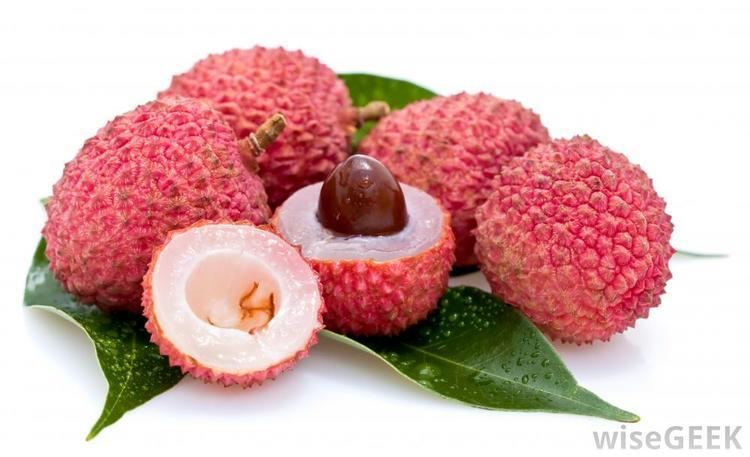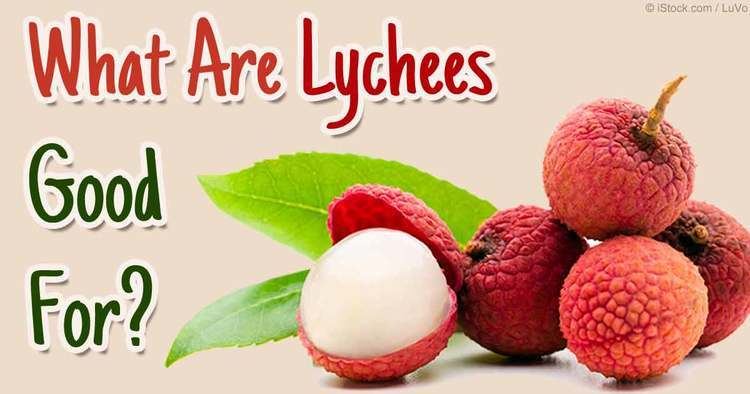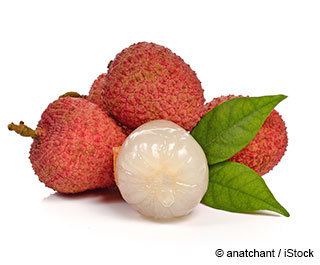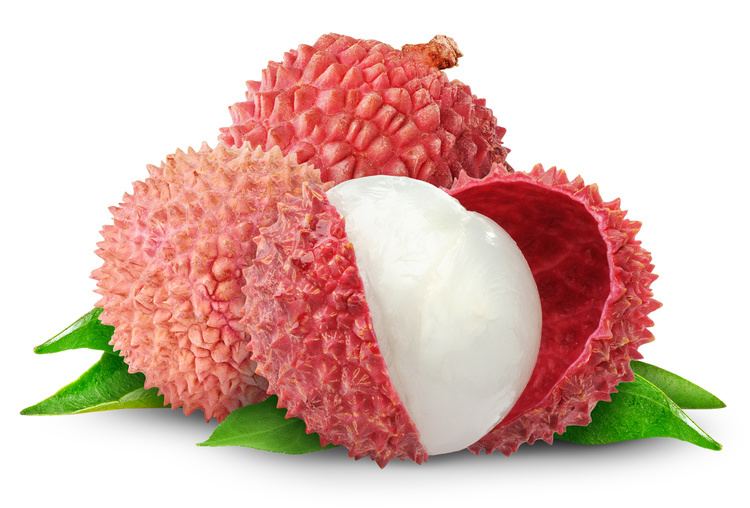Genus LitchiSonn. Rank Species Conservation status Vulnerable | Subfamily Sapindoideae Scientific name Litchi chinensis Higher classification Litchi | |
 | ||
Similar | ||
How to eat a lychee fruit
The lychee, litchi, liechee, liche, lizhi or li zhi, or lichee (Litchi chinensis; Chinese: 荔枝) is the sole member of the genus Litchi in the soapberry family, Sapindaceae.
Contents
- How to eat a lychee fruit
- Top 10 benefits of lychee fruit
- Taxonomy
- Description
- History
- Cultivation and uses
- Cultivars
- Nutrients
- Phytochemicals
- Poisoning
- References

It is a tropical fruit tree native to the Guangdong and Fujian provinces of China, where cultivation is documented 1059 AD. China is the main producer of lychees, followed by India, other countries in Southeast Asia, the Indian Subcontinent and South Africa.

A tall evergreen tree, the lychee bears small fleshy fruits. The outside of the fruit is pink-red, roughly textured and inedible, covering sweet flesh eaten in many different dessert dishes. Since the perfume-like flavor is lost in the process of canning, the fruit is usually eaten fresh.

Litchi contains many phytochemicals; the seeds were found to contain methylenecyclopropylglycine which can cause hypoglycemia, and outbreaks of encephalopathy in Indian and Vietnamese children have been linked to its consumption

Top 10 benefits of lychee fruit
Taxonomy
Litchi chinensis is the sole member of the genus Litchi in the soapberry family, Sapindaceae. It was described and named by French naturalist Pierre Sonnerat in his account "Voyage aux Indes orientales et à la Chine, fait depuis 1774 jusqu'à 1781" (translation: "Voyage to the East Indies and China, made from 1774 to 1781"), which was published in 1782. There are three subspecies, determined by flower arrangement, twig thickness, fruit, and number of stamens.
Description
Litchi chinensis is an evergreen tree that is frequently less than 15 m (49 ft) tall, sometimes reaching 28 m (92 ft).
The bark is grey-black, the branches a brownish-red. Leaves are 10 to 25 cm (3.9 to 9.8 in) or longer, with leaflets in 2-4 pairs. Litchee have a similar foliage to the Lauraceae family likely due to convergent evolution. They are adapted by developing leaves that repel water, and are called laurophyll or lauroid leaves. Flowers grow on a terminal inflorescence with many panicles on the current season's growth. The panicles grow in clusters of ten or more, reaching 10 to 40 cm (3.9 to 15.7 in) or longer, holding hundreds of small white, yellow, or green flowers that are distinctively fragrant.
The lychee bears fleshy fruits that mature in 80–112 days, depending on climate, location, and cultivar. Fruits vary in shape from round to ovoid to heart-shaped, up to 5 cm long and 4 cm wide (2.0 in × 1.6 in), weighing approximately 20g. The thin, tough skin is green when immature, ripening to red or pink-red, and is smooth or covered with small sharp protuberances roughly textured. The rind is inedible but easily removed to expose a layer of translucent white flesh with a floral smell and a fragrant, sweet flavor. The skin turns brown and dry when left out after harvesting. The fleshy, edible portion of the fruit is an aril, surrounding one dark brown inedible seed that is 1 to 3.3 cm long and 0.6 to 1.2 cm wide (0.39–1.30 by 0.24–0.47 in). Some cultivars produce a high percentage of fruits with shriveled aborted seeds known as 'chicken tongues'. These fruit typically have a higher price, due to having more edible flesh. Since the perfume-like flavor is lost in the process of canning, the fruit is usually eaten fresh.
History
Cultivation of lychee began in the region of southern China, going back to 1059 AD, Malaysia, and northern Vietnam. Unofficial records in China refer to lychee as far back as 2000 BC. Wild trees still grow in parts of southern China and on Hainan Island. There are many stories of the fruit's use as a delicacy in the Chinese Imperial Court. It was first described and introduced to the West in 1656 by Michal Boym, a Polish Jesuit missionary (at that time Polish–Lithuanian Commonwealth).
In the 1st century, fresh lychees were in such demand at the Imperial Court that a special courier service with fast horses would bring the fresh fruit from Guangdong. There was great demand for lychee in the Song Dynasty (960-1279), according to Cai Xiang, in his Li chi pu (Treatise on Lychees). It was also the favourite fruit of Emperor Li Longji (Xuanzong)'s favoured concubine Yang Yuhuan (Yang Guifei). The emperor had the fruit delivered at great expense to the capital.
The Chinese classical work, Shanglin Fu, states that the alternate name, meaning leaving its branches, exists, because once the fruit is picked it deteriorates quickly.
The lychee attracted attention of European travelers, such as Juan González de Mendoza in his History of the great and mighty kingdom of China (1585; English translation 1588), based on the reports of Spanish friars who had visited China in the 1570s gave the fruit high praise:
[T]hey haue a kinde of plummes, that they doo call lechias, that are of an exceeding gallant tast, and neuer hurteth any body, although they shoulde eate a great number of them.
The lychee was scientifically described by Pierre Sonnerat (1748–1814) on a return from his travels to China and Southeast Asia. It was then introduced to the Réunion Island in 1764 by Joseph-François Charpentier de Cossigny de Palma. It was later introduced to Madagascar which has become a major producer.
Cultivation and uses
Lychees are extensively grown in China, India, Thailand, Vietnam and the rest of tropical Southeast Asia, the Indian Subcontinent, and more recently in South Africa, Brazil, the Caribbean, Australia and the United States. They require a tropical climate that frost-free not below −4 °C, and with high summer heat, rainfall, and humidity. Growth is best on well-drained, slightly acidic soils rich in organic matter and mulch. A wide range of cultivars are available, with early and late maturing forms suited to warmer and cooler climates respectively. They are also grown as an ornamental tree as well as for their fruit.
According to folklore, a lychee tree that is not producing much fruit can be girdled, leading to more fruit production. When the centre opening of trees is carried out as part of training and pruning, stereo fruiting can be achieved for higher orchard productivity.
Lychees are commonly sold fresh in Asian markets, and in recent years, also widely in supermarkets worldwide. The red rind turns dark brown when the fruit is refrigerated, but the taste is not affected. It is also sold canned year-round. The fruit can be dried with the rind intact, at which point the flesh shrinks and darkens. Dried lychees are often called lychee nuts, though they are not a real nut.
Cultivars
There are numerous lychee cultivars, with considerable confusion regarding their naming and identification. The same cultivar grown in different climates can produce very different fruit. Cultivars can also have different synonyms in various parts of the world. Southeast Asian countries, along with Australia, use the original Chinese names for the main cultivars. India grows more than a dozen different cultivars. South Africa grows mainly the 'Mauritius' cultivar. Most cultivars grown in the United States were imported from China, except for the 'Groff', which was developed in the state of Hawaii.
Different cultivars of lychee are popular in the varying growing regions and countries. In China, popular cultivars include: Sanyuehong, Baitangying, Baila, Shuidong, Feizixiao, Dazou, Heiye, Nuomici, Guiwei, Huaizhi, Lanzhu, and Chenzi. In Vietnam, the most popular cultivar is Vai thieu Hai Duong. In Florida, production is based on several cultivars, including Mauritius, Brewster, and Hak Ip. India grows more than a dozen named cultivars, including Shahi (Highest Pulp %), Dehra Dun, Early Large Red, Kalkattia, Rose Scented.
Nutrients
Fresh whole lychee contains a total 72 mg of vitamin C per 100 grams of fruit, an amount representing 86% of the Daily Value (DV) (table, right). On average, consuming nine peeled lychee fruits would meet an adult’s daily vitamin C requirement (see table).
Phytochemicals
Lychees have moderate amounts of polyphenols, shown in one French study to be higher than several other fruits analyzed, such as grapes and apples. For phenolic composition, flavan-3-ol monomers and dimers were the major compounds representing about 87% of total polyphenols that declined in content during storage or browning. Cyanidin-3-glucoside represented 92% of total anthocyanins. Lychee contains oligonol, a short-chain polyphenol under preliminary evaluation for its potential biological properties.
In traditional Chinese medicine, lychee is known as a fruit with "hot" properties (see the six excesses, for more details on the definition of heat).
Poisoning
In 1962, it was found that lychee seeds contained methylenecyclopropylglycine (MCPG), a homologue of hypoglycin A, which caused hypoglycemia in animal studies. Since the end of the 1990s, unexplained outbreaks of encephalopathy occurred, appearing to affect only children in India and northern Vietnam (where it was called Ac Mong encephalitis after the Vietnamese word for nightmare) during the lychee harvest season from May to June.
A 2013 investigation by the U.S. Centers for Disease Control and Prevention (CDC), in India, showed that cases were linked to the consumption of lychee fruit, causing a noninflammatory encephalopathy that mimicked symptoms of Jamaican vomiting sickness. Because low blood sugar (hypoglycemia) of less than 70 mg/dL in the undernourished children on admission was common, and associated with a poorer outcome (44% of all cases were fatal) the CDC identified the illness as a hypoglycemic encephalopathy.
The investigation linked the illness to hypoglycin A and MCPG toxicity, and to malnourished children eating lychees (particularly unripe ones) on an empty stomach. Other assessment indicated that lychee contains "unusual amino acids" affecting gluconeogenesis and β-oxidation of fatty acids, contributing to acute illness.
The CDC report recommended that parents assure their children limit lychee consumption and have an evening meal, elevating blood glucose levels that may be sufficient to deter illness.
Earlier studies had incorrectly concluded that transmission may occur from direct contact with lychees contaminated by bat saliva, urine, or guano or with other vectors, such as insects found in lychee trees or sand flies, as in the case of Chandipura virus.
